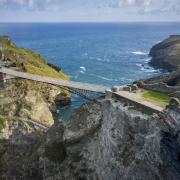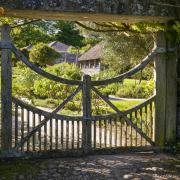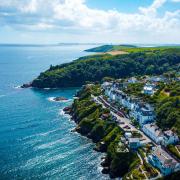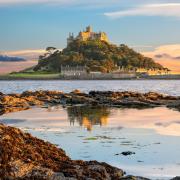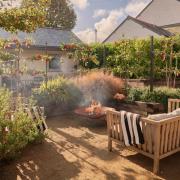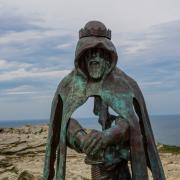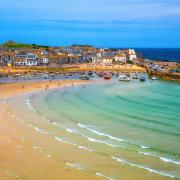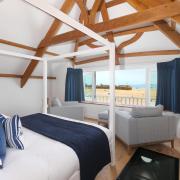Surviving a sacking by the Spanish Armada and under threat from the French, Cornwall was once home to a series of important forts and strategic coastal castles.
Living in a strategically important coastal location it should come as no surprise to find that we have more than our fair share of castles. Many were built in the time of Henry VIII when he fell out with Catholic Europe and the biggest threat to Britain came from across the sea but we also have an interesting selection of castles which were built in the 13th century when Richard, Earl of Cornwall, was in charge of the county. All of the castles featured are now owned by English Heritage to whom we owe a debt of gratitude. They come in various states of disrepair but are all castles that can excite the child within us!
![Great British Life: A view of The Keep, Launceston Castle Great British Life: A view of The Keep, Launceston Castle]() A view of The Keep, Launceston Castle (Image: © David Chapman)
A view of The Keep, Launceston Castle (Image: © David Chapman)
Launceston
After the Norman Conquest William the Conqueror appointed his half-brother, Robert of Mortain, to the new position of ‘the Earl of Cornwall’. He had a timber castle and earthwork constructed at Launceston in about 1068 and made this the base for his operations. The castle was re-built using stone in the 12th century and later developed by Richard, Earl of Cornwall, from 1227.
Later in the 13th century Richard’s son, Edmund, moved the administrative capital of the county to Lostwithiel (Restormel Castle) and this was the beginning of the decline for Launceston Castle. From the early 14th century the castle was used only as a jail, a court and for executions. It was briefly garrisoned in the English Civil War and continued to be used as a jail until 1842 when its remaining prisoners were taken to Bodmin jail.
Owned by English Heritage with charge for entry, check website for opening times/days (opens for 2022 season in April)
![Great British Life: The ruins of Tintagel Castle on The Island Great British Life: The ruins of Tintagel Castle on The Island]() The ruins of Tintagel Castle on The Island (Image: © David Chapman)
The ruins of Tintagel Castle on The Island (Image: © David Chapman)
Tintagel
What a perfect place to build a castle. The headland of Tintagel, now an island, was once connected to the mainland by a narrow isthmus making it easily accessible to friends and yet scarily defendable against foes. Even before there was a castle here, this headland was used as a place of safety for many very important people and a great deal of trade between local people and those from the Mediterranean had taken place for many centuries. It is slightly ironic that by the time the castle was built in the 13th century there was no clear military value, it was simply a folly built by Richard, Earl of Cornwall, to pay homage to the legends surrounding King Arthur.
The Island has now been re-connected to the mainland with an innovative and eye-catching bridge which allows access for people who were previously unable to manage the steep steps and is now an attraction in itself. This is a beautiful, impressive and atmospheric place to visit.
Owned by English Heritage with charge for entry, check website for opening times/days.
Michael Williams, Operations Manager at Tintagel Castle told me “One of the most fascinating elements of Tintagel is the unknown history, and with that, all the theories and myths that surround it. Something that surprises a lot of people is that during the early medieval period it had a bustling trading network to rival London at the time.
'I am delighted that the bridge has opened up access to the site, in August 2019 once the bridge was constructed I had a gentleman who was born and bred in Cornwall and this was the first time he had been able to visit in 40 years. It is what makes this job so special.”
![Great British Life: Restormel Castle is a beautiful example of a motte and bailey castle Great British Life: Restormel Castle is a beautiful example of a motte and bailey castle]() Restormel Castle is a beautiful example of a motte and bailey castle (Image: © David Chapman)
Restormel Castle is a beautiful example of a motte and bailey castle (Image: © David Chapman)
Restormal
It is thought that the first Restormel Castle might have been built in the 11th or 12th centuries but the one we see today was constructed in the 13th century. We know that in 1268 an early form of the castle along with the nearby town of Lostwithiel were granted to Richard, Earl of Cornwall, who already had castles at Launceston and Tintagel. Richard died in 1272 so it is thought likely that his son, Edmund, was responsible for building the majority of the castle in the form that we see today.
Edmund died without an heir and the next significant stage for the castle was in 1337 when the Black Prince became Duke of Cornwall. He recognised the importance of Lostwithiel because of its connection to the tin industry and made extensive repairs to the castle and the associated hunting park.
Since that time the castle has generally declined, only being used in a military capacity briefly in the English Civil War but by that time the castle was deemed to be in a ruinous state.
Owned by English Heritage with charge for entry, check website for opening times/days (opens for 2022 season in April)
![Great British Life: St Catherine’s Castle sits on the headland above Readymoney Cove, seen from Polruan Great British Life: St Catherine’s Castle sits on the headland above Readymoney Cove, seen from Polruan]() St Catherine’s Castle sits on the headland above Readymoney Cove, seen from Polruan (Image: © David Chapman)
St Catherine’s Castle sits on the headland above Readymoney Cove, seen from Polruan (Image: © David Chapman)
St Catherine's
St Catherine’s Castle defends the entrance to the harbour at Fowey, an important, very deep natural harbour. Like Pendennis and St Mawes this castle was built in the time of Henry VIII as part of his coastal defences. The building of St Catherine’s was supervised by Thomas Treffry who went on to oversee work at St Mawes and Pendennis Castles which were much more sophisticated.
St Catherine’s was kept in a good state of repair until it served in the English Civil War but was left to go to ruins soon after. Batteries of guns were installed around the castle in the Crimean War of the mid-19th century and again in the Second World War.
Owned by English Heritage with free access during daylight hours.
![Great British Life: The original part of Pendennis castle is a circular keep Great British Life: The original part of Pendennis castle is a circular keep]() The original part of Pendennis castle is a circular keep (Image: © David Chapman)
The original part of Pendennis castle is a circular keep (Image: © David Chapman)
Pendennis
Pendennis Castle sits high on the headland overlooking the entrance to the Carrick Roads, a strategically important harbour which was vulnerable to attack when Henry VIII fell out with our Catholic neighbours over The Channel. It was Henry who had the first castle built here in the mid-16th century, his circular design enabled guns to be fired in any direction, providing a potent defence.
The threat of attack and invasion persisted into the reign of Elizabeth I so she had the defences extended around the original castle with a large rampart and ditch together with bastions where guns were positioned, whilst on the shore an additional gun tower was constructed. Further improvements were made in the early 17th century and the castle went on to play an important role in the English Civil War when in 1646 it was one of the last major strongholds of the Royalist army.
Owned by English Heritage with charge for entry, check website for opening times/days.
Kirsty Hedderly, Property Manager of Pendennis Castle told me of a magical view: “The view from the castle along the Falmouth coast is pretty magical at any time, but at certain times of the year it gets even more special. Look at the view to the West in late September and you can see the sun going down under the drawbridge of the Tudor keep - it is an Instagram worthy image!” (Note from David: if it happens in September it will also happen in March: perfect timing!)

St Mawes
St Mawes, on The Roseland, sits opposite Falmouth and Pendennis Castle on the eastern entrance to The Carrick Roads. The castle at St Mawes was built in conjunction with that of Pendennis during the reign of Henry VIII. This was part of a massive programme of defensive fortifications along the south coast of England in response to an alliance between France and Spain.
Further threats came towards the end of the 16th century when the Spanish Armada intended to invade through The Carrick Roads but they were deterred by the weather. Defences, in and around the castle, continued to be improved during the Napoleonic Wars and subsequently through to the Second World War.
Owned by English Heritage with charge for entry, check website for opening times/days.
Stephen Jackson, Site Manager at St Mawes Castle, told me that he enjoys interpreting the past through less obvious details: “A very interesting architectural detail for me here at St Mawes – which is very easily overlooked – is the upturned base of a pillar, fitted into the wall at the entrance to the Kitchen, opposite the spiral staircase. It was probably used as a tabletop on which to place trays before going up the stairs or when coming down, and/or to hold a large pail of water from the outside well, for use in the Kitchen. Its source was probably nearby Place Abbey, which after the Dissolution of the Monasteries, most likely had the stone etc robbed out for use in other buildings, as so many did. Legend has it also, that an Anglo-Saxon stone coffin lid is somewhere hidden in the walls, used as building material and probably from the same source.”

Cromwell's Castle
For many years after the Civil War The Royalists continued to hold power on the Isles of Scilly. Cromwell decided to send Admiral Robert Blake to take control of the situation and soon after taking the islands had a castle built in his own name in 1651 on a site which had previously been a blockhouse. The stone used in building the castle was taken from the earlier King Charles’s Castle on high ground above. The purpose of the castle was to send a message of strength to everyone and specifically to defend the heart of the islands primarily from the Dutch who were threatening to invade.
This is a wonderfully placed castle in a stunning location, it is even possible to climb onto the roof for far-reaching views of the islands of Bryher, Tresco and Sampson.
Owned by English Heritage with free access at all times.

Photography tips
Castles tend to be in high places which can make them difficult to photograph, but for some it is a distinct advantage. Launceston Castle is at the highest point of the town but is visible from several positions including Westgate Multi-Storey car park; St Stephen’s Hill (from where Turner painted the castle) and Ridgegrove Lane.
Tintagel Castle, or really I should say Tintagel Island, because the castle is ruinous, is in an extremely photogenic spot. The best view is from the north-east on Barras Nose but the light from this angle is only favourable early in the morning in summer. There is the potential to get shots of the island, the new bridge, the sea and have some colourful flowers in the foreground.
Arguably the most photogenic of all the castles featured in this article is Cromwell’s Castle, Tresco. This is situated in such an idyllic spot and can be photographed from many different angles. It is attractive when viewed from Bryher across the water; it can be photographed from the beach near the Great Pool with a telephoto lens or from the coast path heading north from New Grimsby, but the best viewpoint is from the north side of the castle on the heathland from where the background vista is beautiful. The light is best for this viewpoint on a summer’s evening.
Many of the castles are lit up at night and can make good photos at dusk.
To see more of David’s photography visit his website or look out for his book ‘Photographing Cornwall’ available in all local bookshops.









